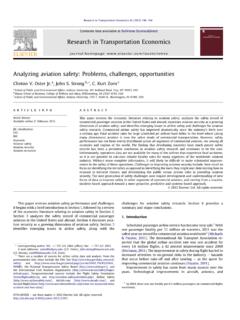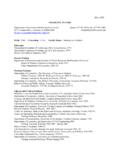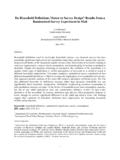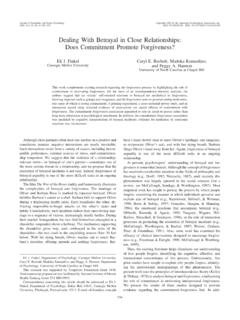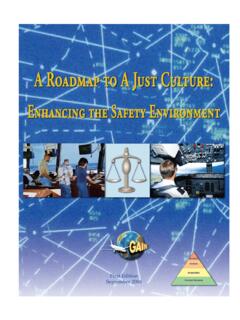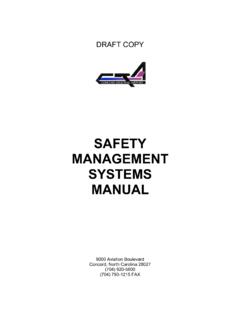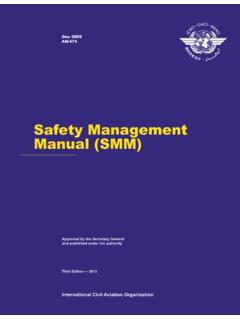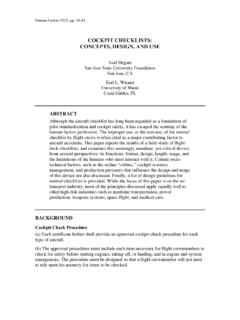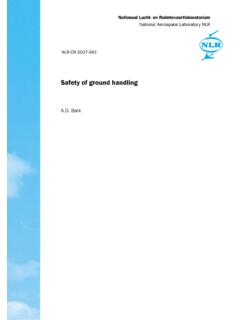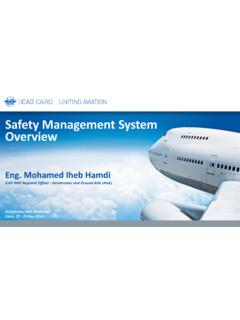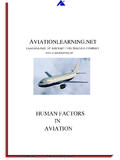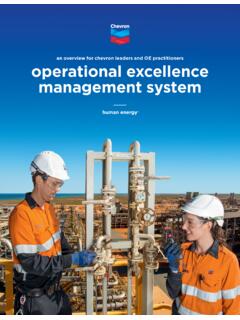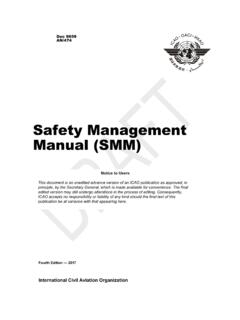Transcription of Analyzing aviation safety: Problems, challenges, opportunities
1 Analyzing aviation safety : Problems, challenges, opportunitiesClinton V. Oster , John S. Strongb,*, C. Kurt ZorncaSchool of Public and Environmental Affairs, Indiana University, 361 Redband Road, Troy, MT 59935, USAbMason School of Business, College of William and Mary, Williamsburg, VA 23187-8795, USAcSchool of Public and Environmental Affairs, Indiana University, 1315 E. Tenth St., Bloomington, IN 47405, USAarticle infoArticle history:Available online 21 February 2013 JEL classification:L93R41 Keywords: aviation safetyAviation securityAviation terrorismabstractThis paper reviews the economic literature relating to aviation safety ; analyzes the safety record ofcommercial passenger aviation in the United States and abroad; examines aviation security as a growingdimension of aviation safety ; and identifies emerging issues in airline safety and challenges for aviationsafety research. Commercial airline safety has improved dramatically since the industry s birth overa century ago.
2 Fatal accident rates for large scheduled jet airlines have fallen to the level where (alongmany dimensions) aviation is now the safest mode of commercial transportation. However, safetyperformance has not been evenly distributed across all segments of commercial aviation , nor among allcountries and regions of the world. Thefinding that developing countries have much poorer safetyrecords has been a persistent conclusion in aviation safety research and continues to be the , operations data are not available for many of the airlines that experience fatal accidents,so it is not possible to calculate reliable fatality rates for many segments of the worldwide aviationindustry. Without more complete information, it will likely be difficult to make substantial improve-ments in the safety of these operations. Challenges to improving aviation security include: how much tofocus on identifying the terrorists as opposed to identifying the tools they might use; determining how torespond to terrorist threats; and determining the public versus private roles in providing aviationsecurity.
3 The next generation of safety challenges now require development and understanding of newforms of data to improve safety in other segments of commercial aviation , and moving from a reactive,incident-based approach toward a more proactive, predictive and systems-based approach. 2012 Elsevier Ltd. All rights paper reviews aviation safety performance and begins with a brief introduction in Section1, followed by a reviewof the economic literature relating to aviation safety in analyzes the safety record of commercial passengeraviation in the United States and abroad. Section4 discusses avia-tion security as a growing dimension of aviation safety . Section5identifies emerging issues in airline safety , along with thechallenges for aviation safety research. Section6 provides asummary and major IntroductionScheduled passenger airline service has become very passenger fatality per million air travelers, 2011 was thesafest year on record for commercial aviation worldwide2(Michaels& Pasztor, 2011).
4 The International Air Transport Association re-ported that the global airline accident rate was one accident forevery millionflights, a 42 percent improvement since 2000(Hersman, 2011). The improvement in safety duringflight has led toincreased attention to on-ground risks in the industryehazardsthat occur before take-off and after landingeas the quest forimproving commercial aviation continues (Pasztor, 2011).Improvement in safety has come from many sources over theyears. Technological improvements in aircraft, avionics, and*Corresponding author. Tel.: 1 757 221 2864 (office); fax: 1 757 221 Zorn).1 There are a number of sources for airline safety data and analysis. From thegovernmental side, these include the FAA ( ); the National Transportation safety Board ( ); andthe International Civil aviation Organization ( ). Nongovernmental sources include the Flight safety Foundation( ), Airline safety ( ), ( ), andAscend FlightGlobal ( ).
5 2In 2004, there was one fatality per million passengers on lists available atSciVerse ScienceDirectResearch in Transportation Economicsjournal homepage: $esee front matter 2012 Elsevier Ltd. All rights in Transportation Economics 43 (2013) 148e164engines have contributed to the betterment of the aviation safetyrecord. Accident investigations have been aided by improvedcockpit voice recorders andflight data recorders. The developmentand use of ground proximity warning devices on aircraft have allbut eliminated a certain type of accident known as controlledflightinto terrain for aircraft equipped with such devices. Aircraft enginesare more reliable and fail less often. Indeed, improvements inaircraft components have resulted in fewer accidents that involveequipment failure. Pilot training has improved through the use andevolution of sophisticatedflight simulators in both initial andrecurrent pilot training. Pilot training has also benefittedimmensely from improved understanding of human factors and theapplication of that understanding to training and aids and air traffic management have also improved,makingflight safer.
6 Improved weather forecasting and betterunderstanding of weather phenomena such as downdrafts andwind shear have also major contributor to the improved safety record can betraced to the careful investigation of past accidents to determinewhat led to the accidents and what needs to be done to preventsuch events from occurring again. This reactive approach toimproving aviation safety has been enhanced by the thoroughanalyses of data from numerous accidents, which has aided in theidentification of recurring patterns or risk factors that are notalways apparent when individual accidents are investigated. Morerecently, proactive approaches to determining ways to improvesafety have become increasingly popular. An example of sucha proactive approach is the analysis of incident data to identifyareas of increased risk that may lead to an Economic analysis of aviation safetyAs might be expected, much of the literature on aviation safetyhas its roots in engineering and technology (Rodrigues & Cusick,2012 ; Stolzer, Halford, & Goglia, 2008).
7 Much of the economicanalyses of airline safety in the 1980s and early 1990s focused onthe potential safety effects of deregulation and liberalization, andthe comparative safety performance of industry segments, espe-cially new entrant carriers. Although the conclusions were mixed,Savage shows that safety records for new entrant airlines in theearly 1990s were worse than for established carriers (Savage,1999).In the past decade though, there has been little variation in safetyamong the major airlines in the developed world. Efforts to analyzecomparative safety performance in the developing world have beenhampered by problems of data availability and Reactive versus proactive approaches to the analysis of aviationsafetyTraditionally the focus of research on aviation safety has been onanalyzing accidents, investigating their causes, and recommendingcorrective action. More recently, in addition to this reactiveapproach to improving aviation safety , increased emphasis hasbeen placed on taking a proactive approach.
8 This approach involvesidentifying emerging risk factors, characterizing these risksthrough modeling exposure and consequences, prioritizing thisrisk, and making recommendations with regard to necessaryimprovements and what factors contributed to the accident. Thisapproach places more emphasis on organizational and systematicrisk factors (GAO, 2012). Economic (reactive) analyses of safetyWhile the worldwide aviation safety record has improveddramatically over time, these safety advances have not been evenlydistributed across all segments of commercial aviation nor amongall countries and regions of the world (Barnett, 2010; Barnett &Higgins, 1989; Barnett & Wang, 2000; Oster, Strong, & Zorn, 1992,2010 ). A handful of researchers, in addition to those identifiedabove, have tried to identify what causes these variations in acci-dent rates among air effect of profitability on an airline s safety record is one areathat has received a fair amount of attention, with mixed in 1986 byGolbefound no significant rela-tionship between airline profitability and (1990)founda significant relationship between profitability and lower accidentrates.
9 Upon a closer analysis of the data, it was determined that thiscorrelation between profitability and safety was present formedium and small airlines but was not statistically significant forlarger airlines. A 1997 analysis of the Canadian airline industry byDionne, Gagn , Gagnon, and Vanasse (1997)identified a negativerelationship between profitability and safety for the smallestairlines analyzed. While on the surface this result might seemcounterintuitive, the investigators discovered that those smallairlines that spent more on maintenance, which would negativelyimpact the bottom line, experienced lower rates of accidents. Arecent update to the Rose analysis found a negative relationshipbetweenfinancial performance and accident rates among aircarriers, especially among smaller regional carriers (Raghavan &Rhoades, 2005). Specifically it was found that the negative rela-tionship between profitability and safety existed for both major andregional airlines but was statistically significant only for the and Singal (2004)use a slightly different methodologyto address the question whether an airlines financial health has animpact on its safety record.
10 They note that previous studies haveidentified a weak or non-existent relationship betweenfinancialhealth and safety and posit that this may be due in part to airlinesenhancing their profitability in the short run by reducing invest-ment in safety . Instead of using profitability as a measure offinancial health, they use bond ratings as a proxy forfinancialperformance. It is determined that airlines with stronger bondratings are safer than those airlines that arefinancially weak. Theauthors emphasize that although they found a correlation betweenfinancial health and airline safety , they were unable to (2012)employs a different approach to determining ifthere is a link between an airline sfinances and its safety record. Intheory, an airline would think about safety as a quality indicatorthat would reduce the competitive focus on prices. In other words,by establishing a better safety record than its competitors, anairline should be able to increase its profitability.
